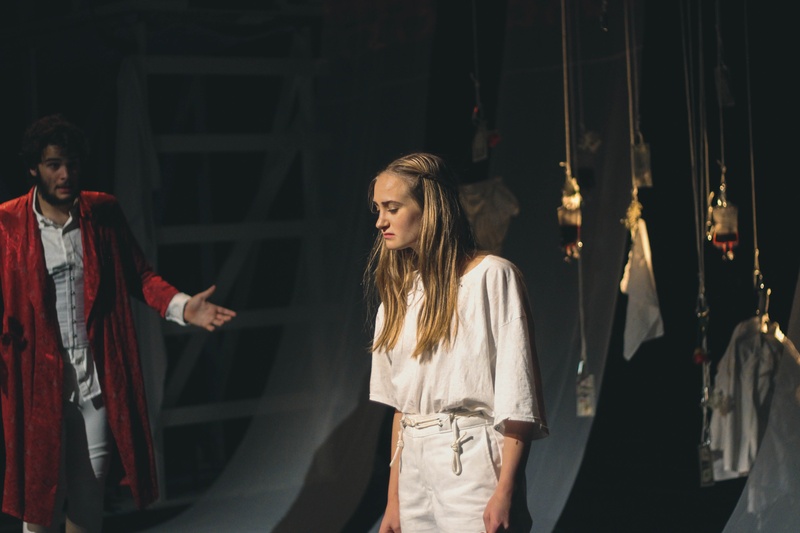{shortcode-9201574401cadc721d67a4fc3189e785faa1d22c}
Under the unique direction of Isaiah O. Michalski ’21, “Hamlet” breaks out of its 16th century Shakespearean mold in a production that proves to be incredibly relevant to the present and riveting until the very end. Its traditional cast of characters is reduced to just seven, which only intensifies the focus on the struggles that go on within even the most seemingly tight-knit groups. Through the 90 minute runtime, Hamlet (Benjamin A. K. Topa ’21), Ophelia (Owen D. Torrey ’21), Horatio (Janiah C. Lockett '20), Laertes (Judy F. Durkin '22), Claudius (Nick Amador ’22), Gertrude (Balim Barutçu ’19), and Polonius (John R. Creed ’20) grace the stage to tell the well-known tale of the Danish court. Michalski takes advantage of the modern medium, unique costuming, lighting, music, and props to tell his version of the story in the Loeb Ex Theatre.
From the opening of the play, the set creates an atmosphere of mystery with dimmed lights, items hanging and juxtaposed in the backdrop, and a running film of a cemetery thrown subtly on the sheets draped from the ceiling. Throughout this first scene, Horatio, Laertes, and Ophelia beautifully show the complex relationships that are shared not only between these characters, but also the rest of the cast. All is not well in Denmark. The three come running from behind the audience, flashlights in hand and terror in their voices. The horror in Ophelia’s voice is real and emotive, setting the stage for a great show.
The play also incorporates minimalistic costuming throughout — the first scene and the last demonstrate the bravado of the beautiful clothes. Within the first minutes of the show, the antagonist is clear: Claudius is adorned in his scarlet regalia. The rest of the cast is completely dressed in white, which represents their supposed purity. By staining the white garb, the blood-soaked finale shows the ultimate corruption of the entire cast. Hamlet’s costume starkly contrasts with the rest of theirs. He is the only other character dressed in different garb: gray, suggesting his unclear morality and the uncertainty of his decisions throughout the show as he battles internal and external demons.
Another example of the excellent costuming can be seen when Laertes returns from her jaunt in France to find her father dead and her brother raped. When talking to the crooked king and the corrupt queen, she pledges herself to their service and swears to end her former friend, Hamlet. This promise is marked by Laertes’ white corset. This single piece of clothing distinguishes her from superficial good.
Laertes’ return, Polonius’ death at the hands of insanity, and Ophelia’s struggles define the show. Michalski and Grob beautifully translate the Shakespearean mood to the modern medium. Truly a paradigm shift, Loeb Ex’s production of “Hamlet” showed the power of subtlety, the poignancy of costuming, and the importance of decisive writing. Although the show is shorter than its true-to-script Shakespearean counterpart, no message is lost. “Hamlet” is a beautiful representation of modern art in the modern day.
Read more in Arts
Portrait of an Artist: Avanti S. Nagral ’20













